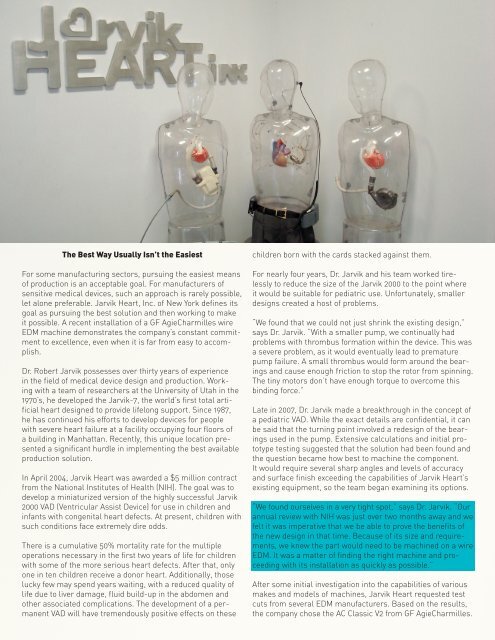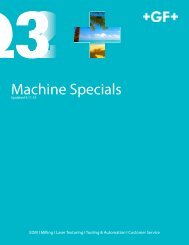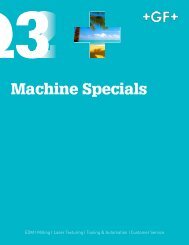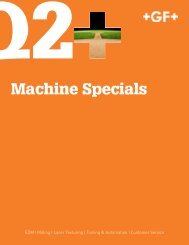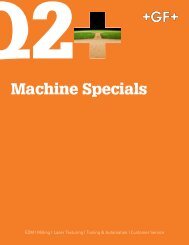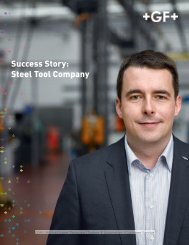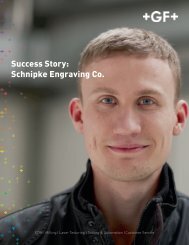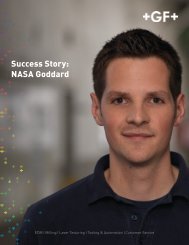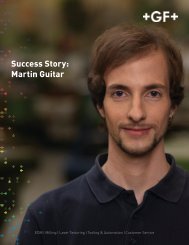Jarvik Heart, Inc.
Create successful ePaper yourself
Turn your PDF publications into a flip-book with our unique Google optimized e-Paper software.
The Best Way Usually Isn’t the Easiest<br />
For some manufacturing sectors, pursuing the easiest means<br />
of production is an acceptable goal. For manufacturers of<br />
sensitive medical devices, such an approach is rarely possible,<br />
let alone preferable. <strong>Jarvik</strong> <strong>Heart</strong>, <strong>Inc</strong>. of New York defines its<br />
goal as pursuing the best solution and then working to make<br />
it possible. A recent installation of a GF AgieCharmilles wire<br />
EDM machine demonstrates the company’s constant commitment<br />
to excellence, even when it is far from easy to accomplish.<br />
Dr. Robert <strong>Jarvik</strong> possesses over thirty years of experience<br />
in the field of medical device design and production. Working<br />
with a team of researchers at the University of Utah in the<br />
1970’s, he developed the <strong>Jarvik</strong>-7, the world’s first total artificial<br />
heart designed to provide lifelong support. Since 1987,<br />
he has continued his efforts to develop devices for people<br />
with severe heart failure at a facility occupying four floors of<br />
a building in Manhattan. Recently, this unique location presented<br />
a significant hurdle in implementing the best available<br />
production solution.<br />
In April 2004, <strong>Jarvik</strong> <strong>Heart</strong> was awarded a $5 million contract<br />
from the National Institutes of Health (NIH). The goal was to<br />
develop a miniaturized version of the highly successful <strong>Jarvik</strong><br />
2000 VAD (Ventricular Assist Device) for use in children and<br />
infants with congenital heart defects. At present, children with<br />
such conditions face extremely dire odds.<br />
There is a cumulative 50% mortality rate for the multiple<br />
operations necessary in the first two years of life for children<br />
with some of the more serious heart defects. After that, only<br />
one in ten children receive a donor heart. Additionally, those<br />
lucky few may spend years waiting, with a reduced quality of<br />
life due to liver damage, fluid build-up in the abdomen and<br />
other associated complications. The development of a permanent<br />
VAD will have tremendously positive effects on these<br />
children born with the cards stacked against them.<br />
For nearly four years, Dr. <strong>Jarvik</strong> and his team worked tirelessly<br />
to reduce the size of the <strong>Jarvik</strong> 2000 to the point where<br />
it would be suitable for pediatric use. Unfortunately, smaller<br />
designs created a host of problems.<br />
“We found that we could not just shrink the existing design,”<br />
says Dr. <strong>Jarvik</strong>. “With a smaller pump, we continually had<br />
problems with thrombus formation within the device. This was<br />
a severe problem, as it would eventually lead to premature<br />
pump failure. A small thrombus would form around the bearings<br />
and cause enough friction to stop the rotor from spinning.<br />
The tiny motors don’t have enough torque to overcome this<br />
binding force.”<br />
Late in 2007, Dr. <strong>Jarvik</strong> made a breakthrough in the concept of<br />
a pediatric VAD. While the exact details are confidential, it can<br />
be said that the turning point involved a redesign of the bearings<br />
used in the pump. Extensive calculations and initial prototype<br />
testing suggested that the solution had been found and<br />
the question became how best to machine the component.<br />
It would require several sharp angles and levels of accuracy<br />
and surface finish exceeding the capabilities of <strong>Jarvik</strong> <strong>Heart</strong>’s<br />
existing equipment, so the team began examining its options.<br />
“We found ourselves in a very tight spot,” says Dr. <strong>Jarvik</strong>. “Our<br />
annual review with NIH was just over two months away and we<br />
felt it was imperative that we be able to prove the benefits of<br />
the new design in that time. Because of its size and requirements,<br />
we knew the part would need to be machined on a wire<br />
EDM. It was a matter of finding the right machine and proceeding<br />
with its installation as quickly as possible.”<br />
After some initial investigation into the capabilities of various<br />
makes and models of machines, <strong>Jarvik</strong> <strong>Heart</strong> requested test<br />
cuts from several EDM manufacturers. Based on the results,<br />
the company chose the AC Classic V2 from GF AgieCharmilles.


